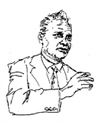



| Eugen Sänger Born 1905 in Preßnitz, Bohemia, Austria-Hungary |
|
 |
||
|
Eugen Sänger, first studied civil engineering at the University of Technology in Graz, but after reading Oberth's book about space travel he changed to the field of aeronautics at the University of Technology in Vienna. It was impossible for him to graduate with a thesis on rockets so instead he wrote one about experi-mental airfoil design and graduated in 1931. In 1932 he started to establish a test-bed for rocket engines at the University of Technology in Vienna, where he worked as an assistant researcher and developed and experimented on different designs of combustion chambers. His famous book “Raketenflugtechnik” (Rocket Flight Engineering) was published 1933. This was the first book on rocketry from an academic professional. His experimental success in designing rocket engines led to engagement as head of his development center for jet engines in Trauen, Germany, in 1936. During WW II he experimented with designs for combustion chambers providing a thrust of up to 100 tons and designs of jet propulsion. Together with his wife Irene Sänger-Bredt, he worked out the detailed plans for a horizontally starting and landing rocket space plane, which could transport a one ton payload into orbit. This so-called “Silbervogel” (Silver Bird) was the prototype of a subsequent series of designs of horizontally starting and landing space planes. In honor of his achievements the German proposal for a next generation space plane is named “Sänger II”. It consists of an airplane for reaching higher altitudes plus the piggy-back rocket plane. After the war he worked for the French government and he was one of the founders of the International Astronautical Federation in 1951. He served as its first president. In 1954 he founded in Stuttgart the Research Institute for Physics of Jet Propulsions. Since 1962 he worked as a professor for jet propulsion in Berlin, Germany. |
||||






